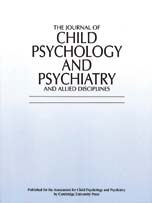Crossref Citations
This article has been cited by the following publications. This list is generated based on data provided by
Crossref.
Szatmari, Peter
2000.
The Classification of Autism, Asperger's Syndrome, and Pervasive Developmental Disorder.
The Canadian Journal of Psychiatry,
Vol. 45,
Issue. 8,
p.
731.
Robinson, Paula D.
Schutz, Chris K.
Macciardi, Fabio
White, Bradley N.
and
Holden, Jeanette J. A.
2001.
Genetically determined low maternal serum dopamine ?-hydroxylase levels and the etiology of autism spectrum disorders.
American Journal of Medical Genetics,
Vol. 100,
Issue. 1,
p.
30.
Jones, Marshall B.
and
Szatmari, Peter
2002.
A risk‐factor model of epistatic interaction, focusing on autism.
American Journal of Medical Genetics,
Vol. 114,
Issue. 5,
p.
558.
SZATMARI, PETER
MÉRETTE, CHANTAL
BRYSON, SUSAN E.
THIVIERGE, JACQUES
ROY, MARC-ANDRE
CAYER, MIREILLE
and
MAZIADE, MICHEL
2002.
Quantifying Dimensions in Autism: A Factor-Analytic Study.
Journal of the American Academy of Child & Adolescent Psychiatry,
Vol. 41,
Issue. 4,
p.
467.
Schutz, Chris K.
Polley, Diana
Robinson, Paula D.
Chalifoux, Maryse
Macciardi, Fabio
White, Bradley N.
and
Holden, Jeanette J.A.
2002.
Autism and the X chromosome: No linkage to microsatellite loci detected using the affected sibling pair method.
American Journal of Medical Genetics,
Vol. 109,
Issue. 1,
p.
36.
ZWAIGENBAUM, LONNIE
SZATMARI, PETER
JONES, MARSHALL B.
BRYSON, SUSAN E.
MACLEAN, JOANNA E.
MAHONEY, WILLIAM J.
BARTOLUCCI, GIAMPIERO
and
TUFF, LAWRENCE
2002.
Pregnancy and Birth Complications in Autism and Liability to the Broader Autism Phenotype.
Journal of the American Academy of Child & Adolescent Psychiatry,
Vol. 41,
Issue. 5,
p.
572.
Tomblin, J. Bruce
Hafeman, Laura L.
and
O'Brien, Marlea
2003.
Autism and autism risk in siblings of children with specific language impairment.
International Journal of Language & Communication Disorders,
Vol. 38,
Issue. 3,
p.
235.
Nicolson, Rob
and
Szatmari, Peter
2003.
Genetic and Neurodevelopmental Influences in Autistic Disorder.
The Canadian Journal of Psychiatry,
Vol. 48,
Issue. 8,
p.
526.
Bishop, Dorothy V.M.
Maybery, Murray
Wong, Dana
Maley, Alana
Hill, Wayne
and
Hallmayer, Joachim
2004.
Are phonological processing deficits part of the broad autism phenotype?.
American Journal of Medical Genetics Part B: Neuropsychiatric Genetics,
Vol. 128B,
Issue. 1,
p.
54.
Bishop, Dorothy V.M.
Maybery, Murray
Maley, Alana
Wong, Dana
Hill, Wayne
and
Hallmayer, Joachim
2004.
Using self‐report to identify the broad phenotype in parents of children with autistic spectrum disorders: a study using the Autism‐Spectrum Quotient.
Journal of Child Psychology and Psychiatry,
Vol. 45,
Issue. 8,
p.
1431.
Jones, Marshall B.
Palmour, Roberta M.
Zwaigenbaum, Lonnie
and
Szatmari, Peter
2004.
Modifier effects in autism at the MAO‐A and DBH loci.
American Journal of Medical Genetics Part B: Neuropsychiatric Genetics,
Vol. 126B,
Issue. 1,
p.
58.
Bishop, Dorothy V.M.
Maybery, Murray
Maley, Alana
Wong, Dana
Hill, Wayne
and
Hallmayer, Joachim
2004.
Using self-report to identify the broad phenotype in parents of children with autistic spectrum disorders: a study using the Autism-Spectrum Quotient.
Journal of Child Psychology and Psychiatry,
Vol. 45,
Issue. 8,
p.
1431.
Fine, Sarah E.
Weissman, Alison
Gerdes, Marsha
Pinto-Martin, Jennifer
Zackai, Elaine H.
McDonald-McGinn, Donna M.
and
Emanuel, Beverly S.
2005.
Autism Spectrum Disorders and Symptoms in Children with Molecularly Confirmed 22q11.2 Deletion Syndrome.
Journal of Autism and Developmental Disorders,
Vol. 35,
Issue. 4,
p.
461.
Ronald, Angelica
Happé, Francesca
and
Plomin, Robert
2005.
The genetic relationship between individual differences in social and nonsocial behaviours characteristic of autism.
Developmental Science,
Vol. 8,
Issue. 5,
p.
444.
Rutter, Michael
2005.
Handbook of Autism and Pervasive Developmental Disorders.
p.
425.
Towbin, Kenneth E.
2005.
Handbook of Autism and Pervasive Developmental Disorders.
p.
165.
Limoges, Élyse
Mottron, Laurent
Bolduc, Christianne
Berthiaume, Claude
and
Godbout, Roger
2005.
Atypical sleep architecture and the autism phenotype.
Brain,
Vol. 128,
Issue. 5,
p.
1049.
Williams, Diane L.
Goldstein, Gerald
Carpenter, Patricia A.
and
Minshew, Nancy J.
2005.
Verbal and Spatial Working Memory in Autism.
Journal of Autism and Developmental Disorders,
Vol. 35,
Issue. 6,
p.
747.
RONALD, ANGELICA
HAPPÉ, FRANCESCA
PRICE, THOMAS S.
BARON-COHEN, SIMON
and
PLOMIN, ROBERT
2006.
Phenotypic and Genetic Overlap Between Autistic Traits at the Extremes of the General Population.
Journal of the American Academy of Child & Adolescent Psychiatry,
Vol. 45,
Issue. 10,
p.
1206.
MITCHELL, SHELLEY
BRIAN, JESSICA
ZWAIGENBAUM, LONNIE
ROBERTS, WENDY
SZATMARI, PETER
SMITH, ISABEL
and
BRYSON, SUSAN
2006.
Early Language and Communication Development of Infants Later Diagnosed with Autism Spectrum Disorder.
Journal of Developmental & Behavioral Pediatrics,
Vol. 27,
Issue. Supplement 2,
p.
S69.


